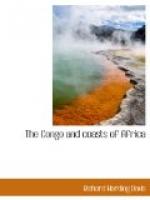THE CONGO AND COASTS OF AFRICA
I
THE COASTERS
No matter how often one sets out, “for to admire, and for to see, for to behold this world so wide,” he never quite gets over being surprised at the erratic manner in which “civilization” distributes itself; at the way it ignores one spot upon the earth’s surface, and upon another, several thousand miles away, heaps its blessings and its tyrannies. Having settled in a place one might suppose the “influences of civilization” would first be felt by the people nearest that place. Instead of which, a number of men go forth in a ship and carry civilization as far away from that spot as the winds will bear them.
When a stone falls in a pool each part of each ripple is equally distant from the spot where the stone fell; but if the stone of civilization were to have fallen, for instance, into New Orleans, equally near to that spot we would find the people of New York City and the naked Indians of Yucatan. Civilization does not radiate, or diffuse. It leaps; and as to where it will next strike it is as independent as forked lightning. During hundreds of years it passed over the continent of Africa to settle only at its northern coast line and its most southern cape; and, to-day, it has given Cuba all of its benefits, and has left the equally beautiful island of Hayti, only fourteen hours away, sunk in fetish worship and brutal ignorance.
One of the places it has chosen to ignore is the West Coast of Africa. We are familiar with the Northern Coast and South Africa. We know all about Morocco and the picturesque Raisuli, Lord Cromer, and Shepheard’s Hotel. The Kimberley Diamond Mines, the Boer War, Jameson’s Raid, and Cecil Rhodes have made us know South Africa, and on the East Coast we supply Durban with buggies and farm wagons, furniture from Grand Rapids, and, although we have nothing against Durban, breakfast food and canned meats. We know Victoria Falls, because they have eclipsed our own Niagara Falls, and Zanzibar, farther up the Coast, is familiar through comic operas and rag-time. Of itself, the Cape to Cairo Railroad would make the East Coast known to us. But the West Coast still means that distant shore from whence the “first families” of Boston, Bristol and New Orleans exported slaves. Now, for our soap and our salad, the West Coast supplies palm oil and kernel oil, and for automobile tires, rubber. But still to it there cling the mystery, the hazard, the cruelty of those earlier times. It is not of palm oil and rubber one thinks when he reads on the ship’s itinerary, “the Gold Coast, the Ivory Coast, the Bight of Benin, and Old Calabar.”
One of the strange leaps made by civilization is from Southampton to Cape Town, and one of its strangest ironies is in its ignoring all the six thousand miles of coast line that lies between. Nowadays, in winter time, the English, flying from the damp cold of London, go to Cape Town as unconcernedly as to the Riviera. They travel in great seagoing hotels, on which they play cricket, and dress for dinner. Of the damp, fever-driven coast line past which, in splendid ease, they are travelling, save for the tall peaks of Teneriffe and Cape Verde, they know nothing.




